As part of our countdown to the 2018 FIFA World Cup in Russia, we are profiling every Australian player who's been to a FIFA World Cup.
And today it’s the turn of one of the stars of that ’74 squad with defender Harry Williams – the first indigenous player to turn out for the Socceroos - in the spotlight.
READ: FIFA World Cup: Countdown for the Caltex Socceroos
Williams was a lightning-fast fullback, known for his electrifying overlapping runs and his superb technique on the ball.
Cap number: 237
World Cups played at: 1974
Position: Defender
Age at World Cup: 23 (now aged 66)
Clubs played for:
St George-Budapest, Canberra City, Inter Monaro
Best World Cup moment:
Williams was an unused substitute for the opening two games of the 1974 tournament but got a taste of the action in the final group match against Chile.
He came on for the last 11 minutes, replacing Col Curran, as the 10-man Socceroos held on for a well-deserved 0-0 draw.
It was the first point ever gained by an Australian team at a FIFA World Cup.

Career highlight:
Williams became the first indigenous player to feature for the Socceroos when he was selected as a 19-year-old for a world tour in 1970 after just six games of senior football.
"I was shocked really - I was just enjoying myself," Williams said in an interview recently of his surprise call-up.
The squad travelled to as many as a dozen different countries playing 15 games, against the likes of Indonesia, Hong Kong, China, Germany, Israel, Mexico and Iran.
His notable career included 43 games for the Socceroos, including 20 full ‘A’ internationals.
Post-playing career:
Williams became the manager of the Indigenous Services and Cultural Diversity Unit for ACT Correctional Services.
Did you know?
Canberra-based Williams helped launch an indigenous soccer tournament - The Harry Williams Cup – which brings indigenous youngsters from around NSW together for a tournament.
*Photographs from the Les Shorrock, Laurie Schwab and Anton Cermak collections are used with permission from Deakin University Library, Eileen Shorrock and Mrs Jana Cermak.
